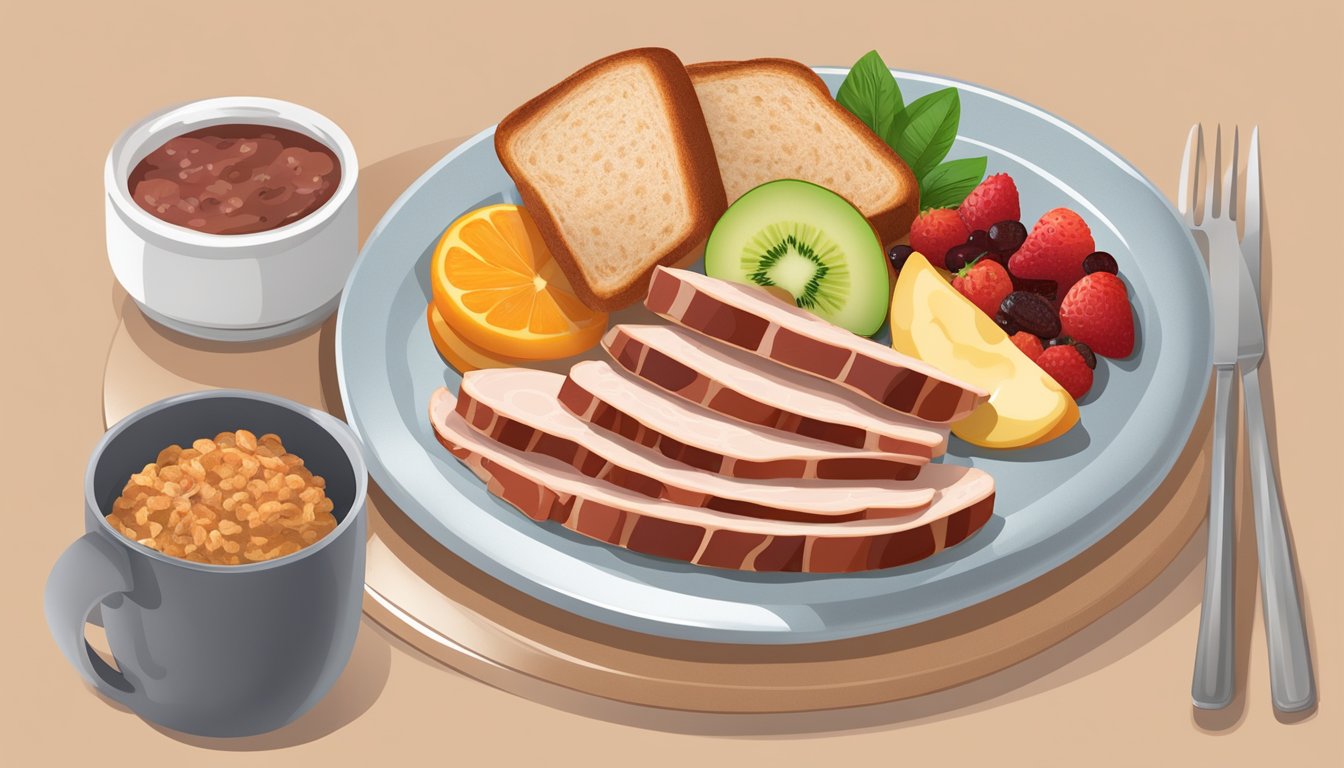Breakfast is often touted as the most important meal of the day, and choosing the right foods can set the tone for healthy eating habits. When it comes to breakfast meats, some options stand out as healthier choices than others. Ground turkey emerges as one of the healthiest breakfast meats due to its lower saturated fat content compared to beef or pork, while still providing ample protein.
Incorporating lean meats into a balanced breakfast can offer numerous health benefits. Protein-rich options like turkey or chicken sausage help maintain muscle mass, support weight management, and provide sustained energy throughout the morning. These leaner alternatives can be part of a nutritious meal when paired with whole grains, fruits, and vegetables.
While moderation is key, opting for healthier breakfast meats doesn’t mean sacrificing flavor. Turkey bacon, Canadian bacon, and lean ham are tasty alternatives that can satisfy cravings while aligning with nutritional goals. By making informed choices about breakfast meats, individuals can enjoy a delicious and nourishing start to their day.
Nutritional Components of Breakfast Meats
Breakfast meats provide essential nutrients that support overall health and energy levels. Their nutritional profiles vary, with protein content being a key factor in their potential benefits.
Protein and Muscle Growth
Protein is crucial for muscle growth and repair. Many breakfast meats are rich sources of this macronutrient. For example, turkey sausage contains about 14 grams of protein per 100 grams, while lean ham provides around 18 grams.
These protein-rich options can contribute to a high-protein breakfast, which may help maintain muscle mass and support recovery after exercise. Protein also promotes satiety, potentially aiding in weight management.
Breakfast meats contain essential amino acids, the building blocks of protein. These amino acids are vital for various bodily functions, including tissue repair and immune system support.
The protein content in breakfast meats can vary:
- Bacon: 37g per 100g
- Pork sausage: 12g per 100g
- Turkey sausage: 14g per 100g
- Lean ham: 18g per 100g
Choosing leaner cuts or poultry-based options can provide protein with less saturated fat. This balance is important for those seeking to increase protein intake while managing overall calorie and fat consumption.
Health Impacts of Saturated Fats and Cholesterol
Saturated fats and cholesterol play significant roles in heart health and disease risk. These dietary components can influence blood lipid profiles and cardiovascular function in important ways.
Understanding Cholesterol Levels
Cholesterol is a waxy substance found in the blood and cells. The body produces cholesterol naturally, but it also comes from food sources. There are two main types of cholesterol:
- LDL (low-density lipoprotein): Often called “bad” cholesterol
- HDL (high-density lipoprotein): Known as “good” cholesterol
High levels of LDL cholesterol can build up in artery walls, increasing the risk of heart disease and stroke. HDL cholesterol helps remove excess cholesterol from the bloodstream.
Diet plays a crucial role in managing cholesterol levels. Foods high in saturated fats can raise LDL cholesterol. Conversely, a diet rich in fruits, vegetables, and lean proteins can help maintain healthy cholesterol levels.
Risks Associated with Saturated Fats
Saturated fats are primarily found in animal-based foods like meat and dairy products. These fats can have negative impacts on heart health when consumed in excess.
Consuming high amounts of saturated fats can:
- Raise LDL cholesterol levels
- Increase inflammation in the body
- Contribute to the formation of arterial plaque
Studies have shown a link between high saturated fat intake and increased risk of heart disease. The American Heart Association recommends limiting saturated fat intake to less than 6% of daily calories.
When choosing breakfast meats, it’s important to consider their saturated fat content. Lean options like turkey or chicken can be healthier alternatives to higher-fat meats like bacon or sausage.
Comparing Meat Types and Cuts
Different breakfast meats vary significantly in their nutritional profiles and health impacts. Factors like processing methods, fat content, and animal source play crucial roles in determining the healthiest options.
Poultry versus Pork
Poultry options like turkey and chicken generally offer leaner protein compared to pork products. Turkey bacon contains fewer calories and less saturated fat than traditional pork bacon. Chicken sausage typically has less fat and calories than pork sausage.
Turkey sausage provides a good balance of flavor and nutrition, with less fat than its pork counterpart. Canadian bacon, made from lean pork loin, offers a healthier alternative to regular bacon with less fat and fewer calories.
Lean Cuts and Healthy Fats
Lean ham slices can be a protein-rich breakfast choice with relatively low fat content. Ground turkey serves as a versatile lean option for breakfast patties or scrambles.
Salmon, while not a traditional breakfast meat, provides high-quality protein and beneficial omega-3 fatty acids. These healthy fats support heart and brain health.
Grass-fed beef contains higher levels of omega-3s and conjugated linoleic acid compared to conventional beef. When consumed in moderation, it can be part of a nutritious breakfast.
The Case for Unprocessed Meats
Unprocessed meats generally contain fewer additives and preservatives than their processed counterparts. Natural ham, without added nitrates or nitrites, may be a healthier choice than heavily processed varieties.
Freshly prepared breakfast meats allow for better control over ingredients and cooking methods. Grilling or baking meats instead of frying can reduce added fats.
Choosing unprocessed meats also helps avoid excess sodium, which is often high in processed breakfast meats like bacon and sausage. This can contribute to better heart health and blood pressure control.
Processed Meats and Additives

Processed breakfast meats often contain additives that can negatively impact health. These additives serve various purposes but may increase risks associated with consuming these products regularly.
Nitrates and Nitrites
Nitrates and nitrites are common preservatives in processed meats like bacon and sausage. They help prevent bacterial growth and maintain color. However, these compounds can form nitrosamines in the body, which are potentially carcinogenic.
Some manufacturers now use celery powder as a “natural” source of nitrates. This doesn’t necessarily make the product healthier, as it still contains nitrates that convert to nitrites.
Uncured or nitrate-free products may be a better option. However, they can still contain naturally occurring nitrates from vegetable sources.
Sodium Content and High Blood Pressure
Processed breakfast meats are often high in sodium. A single serving can contain a significant portion of the recommended daily intake. Excess sodium consumption is linked to high blood pressure, a risk factor for heart disease and stroke.
Added salt serves as a preservative and flavor enhancer. However, it can contribute to water retention and increased blood volume, putting strain on the cardiovascular system.
Reduced-sodium options are available, but they may still contain more sodium than unprocessed meats. Reading labels carefully is crucial for those monitoring their sodium intake.
Calories and Weight Management

Breakfast meats can play a key role in weight management when chosen wisely and consumed in moderation. Selecting lean options and controlling portions are crucial for balancing nutrition and calorie intake.
Portion Control and Sizes
Proper portion sizes are essential for managing calorie intake from breakfast meats. A typical serving of breakfast meat should be about 2-3 ounces, roughly the size of a deck of cards. Turkey bacon and chicken sausage offer lower-calorie alternatives to traditional pork options. For example, two slices of turkey bacon contain approximately 60 calories, while two pork bacon slices have around 90 calories.
Lean ham provides about 15 grams of protein in a 2-ounce serving, making it a satisfying choice without excessive calories. Using measuring tools or visual guides can help maintain consistent portion sizes. Pairing smaller portions of breakfast meats with fiber-rich foods like vegetables or whole grains can increase satiety without adding significant calories.
Balanced Breakfast for Weight Loss
A balanced breakfast that includes lean protein from breakfast meats can support weight loss efforts. Protein helps increase feelings of fullness and may reduce overall calorie intake throughout the day. Combining a small portion of breakfast meat with complex carbohydrates and healthy fats creates a well-rounded meal.
For example, a weight loss-friendly breakfast could include:
- 2 ounces of ground turkey
- 1 whole egg
- 1/2 cup of oatmeal
- 1/2 cup of mixed berries
This combination provides protein, fiber, and essential nutrients while keeping calories in check. Incorporating vegetables like spinach or tomatoes adds volume and nutrients without significantly increasing calorie content. Choosing lower-sodium options and avoiding processed meats can further enhance the nutritional profile of breakfast meals for weight management.
Alternative Protein Sources

Breakfast meats aren’t the only way to start your day with a protein-rich meal. Numerous options provide essential nutrients and can be just as satisfying.
Dairy and Plant-based Options
Greek yogurt packs a protein punch with about 15-20 grams per serving. It’s versatile and can be topped with fruits or nuts for added nutrition. Low-fat cottage cheese is another excellent choice, offering around 14 grams of protein per half-cup.
For plant-based eaters, tofu scrambles provide a hefty dose of protein. One cup of firm tofu contains approximately 20 grams. Chia seeds are small but mighty, offering 4 grams of protein per two tablespoons. They can be added to smoothies or used to make puddings.
Plant-based milk alternatives fortified with protein, such as soy or pea milk, can boost morning protein intake. Some brands offer up to 8 grams of protein per cup.
Eggs and Seafood
Eggs are a breakfast staple for good reason. One large egg provides about 6 grams of high-quality protein. They’re also rich in vitamins and minerals, including vitamin D and choline.
Fish can be an unexpected but nutritious breakfast choice. A 3-ounce serving of salmon delivers around 22 grams of protein. It’s also high in omega-3 fatty acids, which support heart and brain health.
Canned tuna is a convenient option, offering about 20 grams of protein per 3-ounce serving. It’s low in calories and can be mixed with avocado for a quick, protein-rich breakfast.
Smoked salmon paired with whole grain toast or a bagel provides a protein boost and healthy fats. A 3-ounce serving contains approximately 16 grams of protein.
Diet Considerations for a Healthy Breakfast

A balanced breakfast incorporates key nutrients from various food groups. Choosing the right ingredients and understanding nutritional information can optimize your morning meal.
Incorporating Whole Grains and Fiber
Whole grains provide essential fiber, vitamins, and minerals. Opt for oatmeal, whole wheat toast, or bran cereal to start your day. These options offer sustained energy and promote digestive health.
Fiber-rich foods help maintain steady blood sugar levels and keep you feeling full longer. Aim for at least 5 grams of fiber in your breakfast. Add chia seeds, flaxseeds, or wheat germ to boost fiber content.
Whole grain products often contain B vitamins, iron, and magnesium. These nutrients support metabolism and overall health.
Adding Fruits and Vegetables
Fruits and vegetables are packed with vitamins, minerals, and antioxidants. Incorporate berries, bananas, or citrus fruits into your breakfast for natural sweetness and added nutrients.
Vegetables like spinach, kale, or bell peppers can be added to omelets or smoothies. These nutrient-dense options provide folate, vitamin C, and potassium.
Aim for at least one serving of fruits or vegetables with your breakfast. This habit contributes to your daily recommended intake and supports immune function.
Understanding Nutritional Labels
Reading nutritional labels helps make informed choices about breakfast foods. Pay attention to serving sizes, as they may differ from the entire package contents.
Check for added sugars, especially in cereals and flavored yogurts. Opt for products with less than 5 grams of added sugar per serving.
| Nutrient | Recommended Amount |
|---|---|
| Protein | 15-20 grams |
| Fiber | 5+ grams |
| Sugar | <5 grams added |
Look for products high in protein and fiber, but low in saturated fats. Compare similar products to find the most nutritious options for your breakfast routine.
Cooking Methods and Preparation

The way breakfast meats are cooked and prepared significantly impacts their nutritional value and healthfulness. Smart choices at the grocery store and proper cooking techniques can make a big difference.
Label Reading and Grocery Choices
When shopping for breakfast meats, scrutinize nutrition labels carefully. Look for options lower in saturated fat, sodium, and added preservatives. Opt for lean cuts of meat like turkey bacon or Canadian bacon.
Compare different brands to find the healthiest options. Some brands offer reduced-sodium or nitrate-free versions of popular breakfast meats. Check serving sizes to accurately assess nutritional content.
Consider less processed alternatives like plain chicken breast or salmon. These provide high-quality protein without added preservatives or excessive sodium.
Healthier Cooking Techniques
Grilling, baking, and sautéing are healthier cooking methods for breakfast meats. These techniques require little to no added fats, helping reduce overall calorie content.
Use a non-stick pan or cooking spray instead of oil when pan-frying. This minimizes added fats while still achieving a crispy texture. For bacon, try oven-baking on a rack to allow excess fat to drip away.
Avoid deep-frying breakfast meats, as this adds unnecessary calories and unhealthy fats. If using higher-fat meats, blot excess grease with paper towels after cooking.
Pair lean breakfast proteins with whole grains, fruits, or vegetables for a balanced meal. This combination provides fiber and nutrients to complement the protein source.




